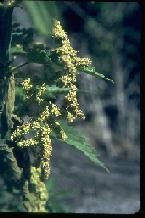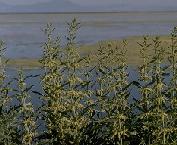

Stinging Nettle
Urtica holosericea Nutt.
A perennial plant with creeping underground rootstalks. The stems are 1 to 6 feet tall with leaves opposite and narrowly lance-shaped. The leaf stalks are about 3/8 to 2 inches long and have stinging hairs, causing irritation to the skin. The blades are thick, ovate, and coarsely toothed. The flowers are 1/16 inch long with four tiny sepals and no petals, greenish colored and inconspicuous. It flower from April to September. The nettle is located along streams and ditches or in waste places where the ground is somewhat moist in plains, foothills, and mountain zones.
Caution: Always wear gloves and long
sleeves when collecting nettles. The acid of the nettle can cause itching from
one to several days.
Food Uses : Young leaves may be steeped to make a drink. Young leaves may also
be used to make a very nutritious food, high in vitamins and minerals, it makes
an excellent spinach substitute and can also be added to soups and stews. Only
the young leaves should be used, because older leaves develop gritty particles
called cystoliths which act as an irritant to the kidneys. Stout gloves should
be worn when harvesting them to prevent irritation. Although the fresh leaves
have stinging hairs, thoroughly drying or cooking them destroys these hairs.
Nettle beer is brewed from the young shoots.
Medicine Uses: The leaves are alterative, ant asthmatic, antidandruff,
antispasmodic and expectorant. A poultice of the mashed plant has been used to
ease the pain of headaches, pains in the neck, sores etc.
The fresh leaves of nettles have been rubbed or beaten onto the skin in the
treatment of rheumatism etc. This practice, called urtification, causes intense
irritation to the skin as it is stung by the nettles. It is believed that this
treatment works in two ways. Firstly, it acts as a counter-irritant, bringing
more blood to the area to help remove the toxins that cause rheumatism.
Secondly, the formic acid from the nettles is believed to have a beneficial
effect upon the rheumatic joints.
Nettle is an excellent styptic, checking the flow of blood from the surface
almost immediately upon application of the powdered root or leaves softened and
bruised. (If left on too long will cause water blisters). It is very
helpful for spitting blood or hemorrhages. In decoction, nettle is
valuable in diarrhea, dysentery, piles, neuralgia, grave, and inflammation of
the kidney. A herbal nettle tea will expel phlegm from the lungs and
stomach and will clean the unary canal. The seeds are used in coughs and
shortness of breath.
Tincture of the fresh plant in flower may be used for agalactia, bee stings,
burns, dysentery, gout, gravel, hemorrhage, rheumatism, sore throats, uremia,
vertigo, whooping cough, and worms.
Nettle has been credited as an antiseptic, astringent, and blood purifier.
